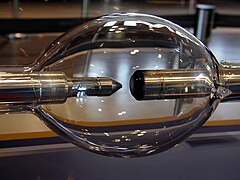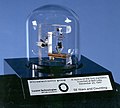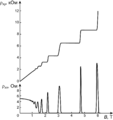Portal:Physics
- Afrikaans
- العربية
- Arpetan
- Azərbaycanca
- বাংলা
- Български
- Bosanski
- Brezhoneg
- Català
- Čeština
- الدارجة
- Deutsch
- Eesti
- Ελληνικά
- Español
- فارسی
- Français
- 한국어
- Հայերեն
- हिन्दी
- Hrvatski
- Bahasa Indonesia
- Italiano
- עברית
- ქართული
- Қазақша
- Kreyòl ayisyen
- Lietuvių
- Magyar
- Македонски
- മലയാളം
- مصرى
- Bahasa Melayu
- Nederlands
- 日本語
- ଓଡ଼ିଆ
- Oʻzbekcha / ўзбекча
- ਪੰਜਾਬੀ
- Picard
- Polski
- Português
- Română
- Runa Simi
- Русский
- Shqip
- සිංහල
- سنڌي
- Slovenčina
- Soomaaliga
- کوردی
- Српски / srpski
- Sunda
- Suomi
- தமிழ்
- Татарча / tatarça
- ไทย
- Türkçe
- Українська
- Tiếng Việt
- 粵語
- Zazaki
- 中文
Portal maintenance status: (June 2018)
automated editing software, and seek consensus before making major changes. Learn how to update the maintenance information here . |
| Physics Portal Main Page | Physics Textbook | Wikiprojects and things to do |
The Physics Portal


Physics is the natural science of matter, involving the study of matter, its fundamental constituents, its motion and behavior through space and time, and the related entities of energy and force. Physics is one of the most fundamental scientific disciplines, with its main goal being to understand how the universe behaves. A scientist who specializes in the field of physics is called a physicist.
Physics is one of the oldest academic disciplines and, through its inclusion of astronomy, perhaps the oldest. Over much of the past two millennia, physics, chemistry, biology, and certain branches of mathematics were a part of natural philosophy, but during the Scientific Revolution in the 17th century these natural sciences emerged as unique research endeavors in their own right. Physics intersects with many interdisciplinary areas of research, such as biophysics and quantum chemistry, and the boundaries of physics are not rigidly defined. New ideas in physics often explain the fundamental mechanisms studied by other sciences and suggest new avenues of research in these and other academic disciplines such as mathematics and philosophy.
Advances in physics often enable new
 Featured article - show another
Featured article - show another

Did you know - show different entries

- ... that Virendra Singh delivered the inaugural Homi Bhabha exchange lecture of the Institute of Physics and Indian Physics Association in 2000?
- ... that Leiden Law School is housed in the former laboratory of Heike Kamerlingh Onnes, a physicist and Nobel laureate?
Selected image - show another
An
-
The 15 kW xenon short-arc lamp used in the IMAX projection system
-
A mercury arc lamp from a fluorescence microscope
-
A krypton long arc lamp (top) is shown above a xenon flashtube. The two lamps, used for laser pumping, are very different in the shape of the electrodes, in particular, the cathode, (on the left).
-
A krypton arc lamp during operation.
-
An electric arc, demonstrating the “arch” effect
Related portals
 Good articles - load new batch
Good articles - load new batch
-
Image 1Ionian Greek; c. 570 – c. 495 BC) was an ancient Ionian Greek philosopher, polymath and the eponymous founder of Pythagoreanism. His political and religious teachings were well known in Magna Graecia and influenced the philosophies of Plato, Aristotle, and, through them, the West in general. Knowledge of his life is clouded by legend; modern scholars disagree regarding Pythagoras's education and influences, but they do agree that, around 530 BC, he travelled to Croton in southern Italy, where he founded a school in which initiates were sworn to secrecy and lived a communal, ascetic lifestyle. This lifestyle entailed a number of dietary prohibitions, traditionally said to have included aspects of vegetarianism.)
The teaching most securely identified with Pythagoras is metempsychosis, or the "transmigration of souls", which holds that every soul is immortal and, upon death, enters into a new body. He may have also devised the doctrine of musica universalis, which holds that the planets move according to mathematical equations and thus resonate to produce an inaudible symphony of music. Scholars debate whether Pythagoras developed the numerological and musical teachings attributed to him, or if those teachings were developed by his later followers, particularly Philolaus of Croton. Following Croton's decisive victory over Sybaris in around 510 BC, Pythagoras's followers came into conflict with supporters of democracy, and Pythagorean meeting houses were burned. Pythagoras may have been killed during this persecution, or he may have escaped to Metapontum and died there. (Full article...Image 2wave theory of light, which he described in his Traité de la Lumière (1690). His theory of light was initially rejected in favour of Newton's corpuscular theory of light, until Augustin-Jean Fresnel adapted Huygens's principle to give a complete explanation of the rectilinear propagation and diffraction effects of light in 1821. Today this principle is known as the Huygens–Fresnel principle. (Full article...)Image 3aurorae, and for his book on these subjects, From the Depths of Space to the Heart of the Atom. He worked for many years as a professor of mathematics at the University of Oslo in Norway. A crater on the far side of the Moon is named after him. (Full article...)Image 4In 1850, Léon Foucault used a rotating mirror to perform a differential measurement of the speed of light in water versus its speed in air. In 1862, he used a similar apparatus to measure the speed of light in the air. (Full article...)Image 5interference in quantitative terms, and supposing that simple colors consist of sinusoidal waves, Fresnel gave the first satisfactory explanation of diffraction by straight edges, including the first satisfactory wave-based explanation of rectilinear propagation. Part of his argument was a proof that the addition of sinusoidal functions of the same frequency but different phases is analogous to the addition of forces with different directions. By further supposing that light waves are purely transverse, Fresnel explained the nature of polarization, the mechanism of chromatic polarization, and the transmission and reflection coefficients at the interface between two transparent isotropic media. Then, by generalizing the direction-speed-polarization relation for calcite, he accounted for the directions and polarizations of the refracted rays in doubly-refractive crystals of the biaxial class (those for which Huygens's secondary wavefronts are not axisymmetric). The period between the first publication of his pure-transverse-wave hypothesis, and the submission of his first correct solution to the biaxial problem, was less than a year. (Full article...)Image 6gold foil experiment of Hans Geiger and Ernest Marsden. In this model, atoms had their mass and positive electric charge concentrated in a very small nucleus. By 1920, isotopes of chemical elements had been discovered, the atomic masses had been determined to be (approximately) integer multiples of the mass of the hydrogen atom, and the atomic number had been identified as the charge on the nucleus. Throughout the 1920s, the nucleus was viewed as composed of combinations of protons and electrons, the two elementary particles known at the time, but that model presented several experimental and theoretical contradictions.)
The essential nature of the atomic nucleus was established with the discovery of the neutron by James Chadwick in 1932 and the determination that it was a new elementary particle, distinct from the proton. (Full article...Image 7expanding. (Full article...)Image 8professor emeritus of physics at the University of Cambridge. Best known for his pioneering work on superconductivity and quantum tunnelling, he was awarded the Nobel Prize in Physics in 1973 for his prediction of the Josephson effect, made in 1962 when he was a 22-year-old PhD student at Cambridge University. Josephson is the first Welshman to have won a Nobel Prize in Physics. He shared the prize with physicists Leo Esaki and Ivar Giaever, who jointly received half the award for their own work on quantum tunnelling.)
Josephson has spent his academic career as a member of the Theory of Condensed Matter group at Cambridge's Cavendish Laboratory. He has been a fellow of Trinity College, Cambridge since 1962, and served as professor of physics from 1974 until 2007. (Full article...Image 9measure theory and the theory of distributions.)
The delta function was introduced by physicist Paul Dirac, and has since been applied routinely in physics and engineering to model point masses and instantaneous impulses. It is called the delta function because it is a continuous analogue of the Kronecker delta function, which is usually defined on a discrete domain and takes values 0 and 1. The mathematical rigor of the delta function was disputed until Laurent Schwartz developed the theory of distributions, where it is defined as a linear form acting on functions. (Full article...Image 10atomic bombs and suggested that the United States should start its own nuclear program. It prompted action by Roosevelt, which eventually resulted in the Manhattan Project, the development of the first atomic bombs, and the use of these bombs on the cities of Hiroshima and Nagasaki. (Full article...)Image 11Feynman diagrams. It has been said that physicists have made use of his principles and developments "often without knowing it, and generally without quoting him." The Ising model was another one of his research interests. (Full article...)Image 12X-rays or the use of ionizing radiation, which distinguishes it from computed tomography (CT) and positron emission tomography (PET) scans. MRI is a medical application of nuclear magnetic resonance (NMR) which can also be used for imaging in other NMR applications, such as NMR spectroscopy.)
MRI is widely used in hospitals and clinics for medical diagnosis, staging and follow-up of disease. Compared to CT, MRI provides better contrast in images of soft tissues, e.g. in the brain or abdomen. However, it may be perceived as less comfortable by patients, due to the usually longer and louder measurements with the subject in a long, confining tube, although "open" MRI designs mostly relieve this. Additionally, implants and other non-removable metal in the body can pose a risk and may exclude some patients from undergoing an MRI examination safely. (Full article...Image 13Robert Oppenheimer, the leading theoretical physicist in the United States at that time. Christy received his doctorate in 1941 and joined the physics department of Illinois Institute of Technology. (Full article...)Image 14
Fourteenth-century drawing of angels turning the celestial spheres
Ancient, medieval and Renaissance astronomers and philosophers developed many different theories about the dynamics of the celestial spheres. They explained the motions of the various nested spheres in terms of the materials of which they were made, external movers such as celestial intelligences, and internal movers such as motive souls or impressed forces. Most of these models were qualitative, although a few of them incorporated quantitative analyses that related speed, motive force and resistance. (Full article...)Image 15Kaiser Wilhelm Institute for Physical Chemistry and Electrochemistry at Berlin-Dahlem, writing her thesis on the spectra of alkali metal halides under the supervision of Peter Pringsheim [de] and Fritz Haber. By the time she completed it in 1934, the Nazi Party had been elected to office in Germany, and Jews were no longer allowed to be hired for academic positions. She went to Denmark where she found a position at the Niels Bohr Institute of Theoretical Physics at the University of Copenhagen. Working with James Franck and George de Hevesy, she published a number of papers on the use of radioactive substances in biology. (Full article...)April anniversaries
- 1 April 1997 – Comet Hale-Boppat perihelion
- 12 April 1633 – Galileo Galilei's trial starts
- 15 April 1707 – Leonhard Euler's birthday
- 18 April 1955 – Albert Einstein's death
- 22 April 1904 – J. Robert Oppenheimer's birthday
- 23 April 1858 – Max Planck's birthday
- 24 April 1990 – Hubble Space Telescope launched
- 25 April 1990 – Hubble Space Telescope deployed from the shuttle Discovery
- 30 April 1777 – Carl Friedrich Gauss's birthday
General images
The following are images from various physics-related articles on Wikipedia.-
Image 1BCE) (from History of physics)
-
Image 2One possible signature of a Higgs boson from a simulated proton–proton collision. It decays almost immediately into two jets of hadrons and two electrons, visible as lines. (from History of physics)
-
Image 5Marie Skłodowska-Curie
(1867–1934) She was awarded two Nobel prizes, Physics (1903) and Chemistry (1911) (from History of physics) -
Image 6Galileo Galilei, early proponent of the modern scientific worldview and method
(1564–1642) (from History of physics) -
Image 8Star maps by the 11th-century Chinese polymath Su Song are the oldest known woodblock-printed star maps to have survived to the present day. This example, dated 1092, employs the cylindrical equirectangular projection. (from History of physics)
-
Image 11Chien-Shiung Wu worked on parity violation in 1956 and announced her results in January 1957. (from History of physics)
-
Image 16mass spectrometer. He was awarded the Nobel Prize in Physics in 1906. (from History of physics)
-
Image 17A replica of the firstBell labs (from Condensed matter physics)
-
Image 18Johannes van der Waals with the helium liquefactor at Leiden in 1908 (from Condensed matter physics)
-
Image 19A composite montage comparing Jupiter (lefthand side) and its four Galilean moons (top to bottom: Io, Europa, Ganymede, Callisto). (from History of physics)
-
Image 20Einstein proposed thatcurving ("bending") the spacetime in which they exist, altering the paths they follow within it. (from History of physics)
-
Image 22Computer simulation of nanogears made of fullerene molecules. It is hoped that advances in nanoscience will lead to machines working on the molecular scale. (from Condensed matter physics)
-
Image 23The ancient Greek mathematician Archimedes, famous for his ideas regarding fluid mechanics and buoyancy. (from History of physics)
-
Image 25The Polish astronomer Nicolaus Copernicus (1473–1543) is remembered for his development of a heliocentric model of the Solar System. (from History of physics)
-
Image 27William Thomson (Lord Kelvin))
(1824–1907) (from History of physics -
Image 28The first Bose–Einstein condensate observed in a gas of ultracold rubidium atoms. The blue and white areas represent higher density. (from Condensed matter physics)
-
Image 30Aantiquark pair and a gluon (green spiral) is released. (from History of physics)
-
Image 32Classical physics is usually concerned with everyday conditions: speeds are much lower than the speed of light, sizes are much greater than that of atoms, yet very small in astronomical terms. Modern physics, however, is concerned with high velocities, small distances, and very large energies. (from Modern physics)
-
Image 34The Hindu-Arabic numeral system. The inscriptions on the edicts of Ashoka (3rd century BCE) display this number system being used by the Imperial Mauryas. (from History of physics)
-
Image 35Classical physics (Rayleigh–Jeans law, black line) failed to explain black-body radiation – the so-called ultraviolet catastrophe. The quantum description (Planck's law, colored lines) is said to be modern physics. (from Modern physics)
-
Image 38Ahigh-temperature superconductor. Today some physicists are working to understand high-temperature superconductivity using the AdS/CFT correspondence. (from Condensed matter physics)
-
Image 39A page fromAlgebra. (from History of physics)
-
Image 40The quantum Hall effect: Components of the Hall resistivity as a function of the external magnetic field (from Condensed matter physics)
Categories

Category puzzle Fundamentals: Concepts in physics | Constants | Physical quantities | Units of measure | Mass | Length | Time | Space | Energy | Matter | Force | Gravity | Electricity | Magnetism | Waves
Basic physics: Mechanics | Electromagnetism | Statistical mechanics | Thermodynamics | Quantum mechanics | Theory of relativity | Optics | Acoustics
Specific fields: Acoustics | Astrophysics | Atomic physics | Molecular physics | Optical physics | Computational physics | Condensed matter physics | Nuclear physics | Particle physics | Plasma physics
Tools: Detectors | Interferometry | Measurement | Radiometry | Spectroscopy | Transducers
Background: Physicists | History of physics | Philosophy of physics | Physics education | Physics journals | Physics organizations
Other: Physics in fiction | Physics lists | Physics software | Physics stubs
Physics topics
thermodynamics. The term Modern physics is normally used for fields which rely heavily on quantum theory, including quantum mechanics, atomic physics, nuclear physics, particle physics and condensed matter physics. General and special relativityare usually considered to be part of modern physics as well.More recognized content
Associated Wikimedia
The following Wikimedia Foundation sister projects provide more on this subject:
-
Commons
Free media repository -
Wikibooks
Free textbooks and manuals -
Wikidata
Free knowledge base -
Wikinews
Free-content news -
Wikiquote
Collection of quotations -
Wikisource
Free-content library -
Wikiversity
Free learning tools -
Wikivoyage
Free travel guide -
Wiktionary
Dictionary and thesaurus
Sources
Portals on Wikipedia






































































